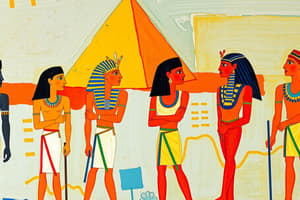Podcast
Questions and Answers
Thotmes I began the additions to the Temple of ______.
Thotmes I began the additions to the Temple of ______.
Ammon
Kharnak is famous for the erection of the earliest known ______.
Kharnak is famous for the erection of the earliest known ______.
obelisk
Hatshepsut is known for her Funerary Temple at ______.
Hatshepsut is known for her Funerary Temple at ______.
Deir el-Bahari
Rameses I began the construction of the 'Great Hypostyle Hall' at ______.
Rameses I began the construction of the 'Great Hypostyle Hall' at ______.
Amenophis III erected the 'Colossi of ______', one of the wonders of the world.
Amenophis III erected the 'Colossi of ______', one of the wonders of the world.
The highest priest in Egypt is known as the ______.
The highest priest in Egypt is known as the ______.
The most powerful official next to the king is called the ______.
The most powerful official next to the king is called the ______.
In the structure of a monarchy, the ______ typically succeeds the throne.
In the structure of a monarchy, the ______ typically succeeds the throne.
The ______ controls the royal treasuries and supervises the census.
The ______ controls the royal treasuries and supervises the census.
Hieroglyphics are a form of ______ used in ancient Egyptian writing.
Hieroglyphics are a form of ______ used in ancient Egyptian writing.
Pictorial representation of religious rituals and historical events are depicted in ______.
Pictorial representation of religious rituals and historical events are depicted in ______.
The king's personal estate and household are managed by the ______.
The king's personal estate and household are managed by the ______.
The lowest form in the social ranks of ancient Egypt refers to ______.
The lowest form in the social ranks of ancient Egypt refers to ______.
Egypt has only two seasons: SPRING and ______.
Egypt has only two seasons: SPRING and ______.
Pyramids were built for the preservation of the ______ body.
Pyramids were built for the preservation of the ______ body.
Pharaoh not only serves as king but also as ______, the political and religious ruler.
Pharaoh not only serves as king but also as ______, the political and religious ruler.
The ancient Egyptians were ______ in theory and Polytheistic in practice.
The ancient Egyptians were ______ in theory and Polytheistic in practice.
The 30 dynasties in Egypt started from the 3rd Millennium ______.
The 30 dynasties in Egypt started from the 3rd Millennium ______.
The first type of tomb developed in the Ancient Kingdom is called a ______.
The first type of tomb developed in the Ancient Kingdom is called a ______.
Mentuhotep II developed the 3rd type of tomb known as ______-cut.
Mentuhotep II developed the 3rd type of tomb known as ______-cut.
Egypt was part of the Persian Empire for ______ centuries.
Egypt was part of the Persian Empire for ______ centuries.
Flashcards are hidden until you start studying
Study Notes
Government Structure in Ancient Egypt
- Monarchy is the governing system, with the Pharaoh serving as both king and the highest priest.
- The Pharaoh's son is the typical successor to the throne.
- The Vizier acts as the Pharaoh's most powerful official, assisting in governance.
- The Chancellor manages royal treasuries, granaries, and oversees census activities.
- The Chief Steward is responsible for the Pharaoh's personal estate and household management.
Social Hierarchy
- Noble Families occupy the highest social rank, closely associated with the royal family.
- Second tier includes Viziers, Chancellors, and Chief Stewards, holding leadership roles next to the Pharaoh.
- Fishermen, Farmers, Craftsmen, and Merchants represent ordinary Egyptians with essential roles in society.
- Slaves constitute the lowest social class, having the least rights and privileges.
Architectural Contributions
- Thotmes I initiated the Temple of Ammon's expansions at Karnak.
- Senusrets erected Egypt's earliest known obelisk at Heliopolis.
- Hatshepsut, a noted queen, is recognized for her impressive Funerary Temple at Deir el-Bahari.
- Amenemhat I established the Great Temple of Ammon at Karnak, notable for its grandeur.
- Amenophis III constructed the Colossi of Memnon, classified as one of the world’s wonders.
- Rameses I began the Great Hypostyle Hall at Karnak, while Rameses II completed its construction and the Rock Temple at Abu Simbel.
Religious Beliefs
- The construction of pyramids stemmed from beliefs in life after death and the preservation of the deceased.
- Pharaohs are viewed as "Gods," ruling both politically and religiously, and upon death, they become Osiris, the god of the dead.
- The society is monotheistic in theory while practicing polytheism with a multitude of deities.
Environmental and Climatic Factors
- Egypt experiences only two seasons: Spring and Summer, characterized by a warm climate with scarce rainfall.
- Structures lack gutters and downspouts because rain is infrequent; windows were minimal to combat heat and sandstorms.
Historical Timeline
- Ancient Egypt comprised 30 dynasties from the 3rd Millennium B.C. to the Roman period, including a two-century Persian occupation before Alexander the Great's invasion.
- The Ancient Kingdom (1st-10th dynasty) saw the development of two tomb types: the Mastaba and the Pyramid.
- The Middle Kingdom (11th-17th dynasty) introduced a third type of tomb known as "rock-cut."
- Notable personalities include Mentuhetep II from the Middle Kingdom who expanded tomb architecture.
Ptolemaic Period Highlights
- Ptolemy II is known for constructing the Lighthouse of Alexandria.
- Ptolemy III founded the Great Serapeum, a significant temple in Alexandria.
Studying That Suits You
Use AI to generate personalized quizzes and flashcards to suit your learning preferences.




